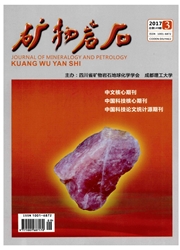

 中文摘要:
中文摘要:
青海果洛龙洼金矿区内发育若干基性岩脉,侵位于变质岩性系中,呈灰绿色-灰黑色,具有致密块状构造和残余辉绿-辉长及斑状结构特征。主要矿物为斜长石、蚀变辉石、角闪石和碳酸盐矿物等,副矿物有榍石、锆石及磷灰石等(总量小于1%)。斑晶主要为斜长石斑晶,辉石基本蚀变,基质成分复杂,主要有斜长石、辉石、绿泥石及副矿物。岩石蚀变强烈,主要有透闪石-阳起石化、绿泥石-绿帘石化和碳酸盐化。岩石主量成分中,w(SiO2)(44.1%~48.5%)偏低,w(MgO)(8.3%~12.28%)和w(CaO)(8.84%~10.9%)偏高,与基性岩及碳酸盐化等蚀变特征吻合。基性岩中锆石含量少,且粒度小,但具有岩浆锆石的韵律环带结构特征。LA-ICP-Ms锆石U-Pb测年结果,显示两组年龄,分别为416.2Ma±3.5Ma(MSWD-0.25,N-6)和487.5Ma±4.0Ma(MSWD=0.92,N=3)。其中年龄较老的锆石,均具有较高的磨圆度,可能为继承或捕获锆石。因此,416.2Ma±3.5Ma,可能代表果洛龙洼基性岩脉的结晶年龄,与清水泉辉绿岩及纳赤台群中次火山岩具有基本一致的结晶年龄。该年龄不仅限定了果洛龙洼金矿赋矿地层老于泥盆纪,将其重新归为纳赤台群,也表明该期基性岩浆作用与区域印支期造山型金矿床的形成,没有直接的成因联系。全部基性岩脉稀土总量(∑REE-51.35×10-6~101.4×10-6)较低,LREE相对富集,Eu和Ce异常不显著。全岩富集大离子亲石元素(K-Rb-Ba-Sr),但亏损高场强元素(Nb-Ta-Ti-Y),具有岛弧钙碱性系列的特征,可能与早古生代晚期古特提斯洋壳俯冲消减的弧后拉张裂解作用有关。
 英文摘要:
英文摘要:
Intruded in metamorphic rocks, basic dykes are well developed in the Guoluolongwa gold ore field, Qinghai Province, with gray-green and dark gray color, and with compact lump structure and residual diabase and gabbro and porphyritic textures. The main minerals composi- tions are plagioclase, pyroxene, hornblendes and carbonate minerals, with titanite, zircon and apa- tire (less than 1%) as accessory minerals. Phenocrysts are composed of plagioclase and highly al- tered pyroxene. Complex matrix consists of mainly plagioclase, pyroxene, chlorite and accessory minerals. Rocks are strongly altered evidenced by tremolite actinolitization, chlorite epidotization and carbonatization. The major components in the rocks are consistent with carbonate alteration features with low w(SiO2) (44. 1% to 48.5%),high w(MgO) (8.3% to 12.28~//00) and w(CaO) (8.84 %to 10.9 %), consistent with the basic rocks and carbonatization features. Zircon grains in the basic dykes are rare and small with organized oscillatory zoning feature of magmatic origin. LA-ICP-MS dating reveals forming ages of 416.2 Ma±3.5 Ma (MSWD=0.25 ,N=6) and 487.5 Ma±4.0 Ma (MSWD=0.92,N=3) respectively. The older ones among the zircons are of better psephicity,which are probably inheritance or captured zircons. Therefore, the age of 416.2 Ma±3.5 Ma should represent the crystallization age of basic dykes and is in accordance with the crys- tallization age of Qingshuiquan diabase and volcanic rock of the Nachitai Group. The determined age indicates that Guoluolongwa gold deposit ore-bearing strata can be classified in Nachitai Group,and the basic magmatism has no direct genetic link with regional Indosinian orogenic type gold deposit. Basic dykes are with relatively lower rare earth (∑REE= 51.35×10-6 to 101.4 × 10-6) and enriched in LREE,Eu and Ce anomalies are not obvious. Meanwhile,theses basic dykes are rich in large ion lithophile elements (K-Rb-Ba-Sr) and depleted in high magnetic field strength elements (Nb-Ta-
 同期刊论文项目
同期刊论文项目
 同项目期刊论文
同项目期刊论文
 Geological and sulfur–lead–strontium isotopic studies of the Shaojiwan Pb–Zn deposit, southwest Chin
Geological and sulfur–lead–strontium isotopic studies of the Shaojiwan Pb–Zn deposit, southwest Chin H-O-S-Cu-Pb Isotopic Constraints on the Origin of the Nage Cu-Pb Deposit, Southeast Guizhou Province
H-O-S-Cu-Pb Isotopic Constraints on the Origin of the Nage Cu-Pb Deposit, Southeast Guizhou Province Geology and C-O isotope geochemistry of carbonate-hosted Pb-Zn deposits, NW Guizhou Province, SW Chi
Geology and C-O isotope geochemistry of carbonate-hosted Pb-Zn deposits, NW Guizhou Province, SW Chi The origin of the Maozu carbonate-hosted Pb–Zn deposit, southwest China: Constrained by C–O–S–Pb iso
The origin of the Maozu carbonate-hosted Pb–Zn deposit, southwest China: Constrained by C–O–S–Pb iso 期刊信息
期刊信息
